Defenders of Tahrir Square take cover behind tanks as pro-Mubarak supporters launch stones against them at the square’s Qasr el-Nil entrance (all photos courtesy Iason Athanasiadis)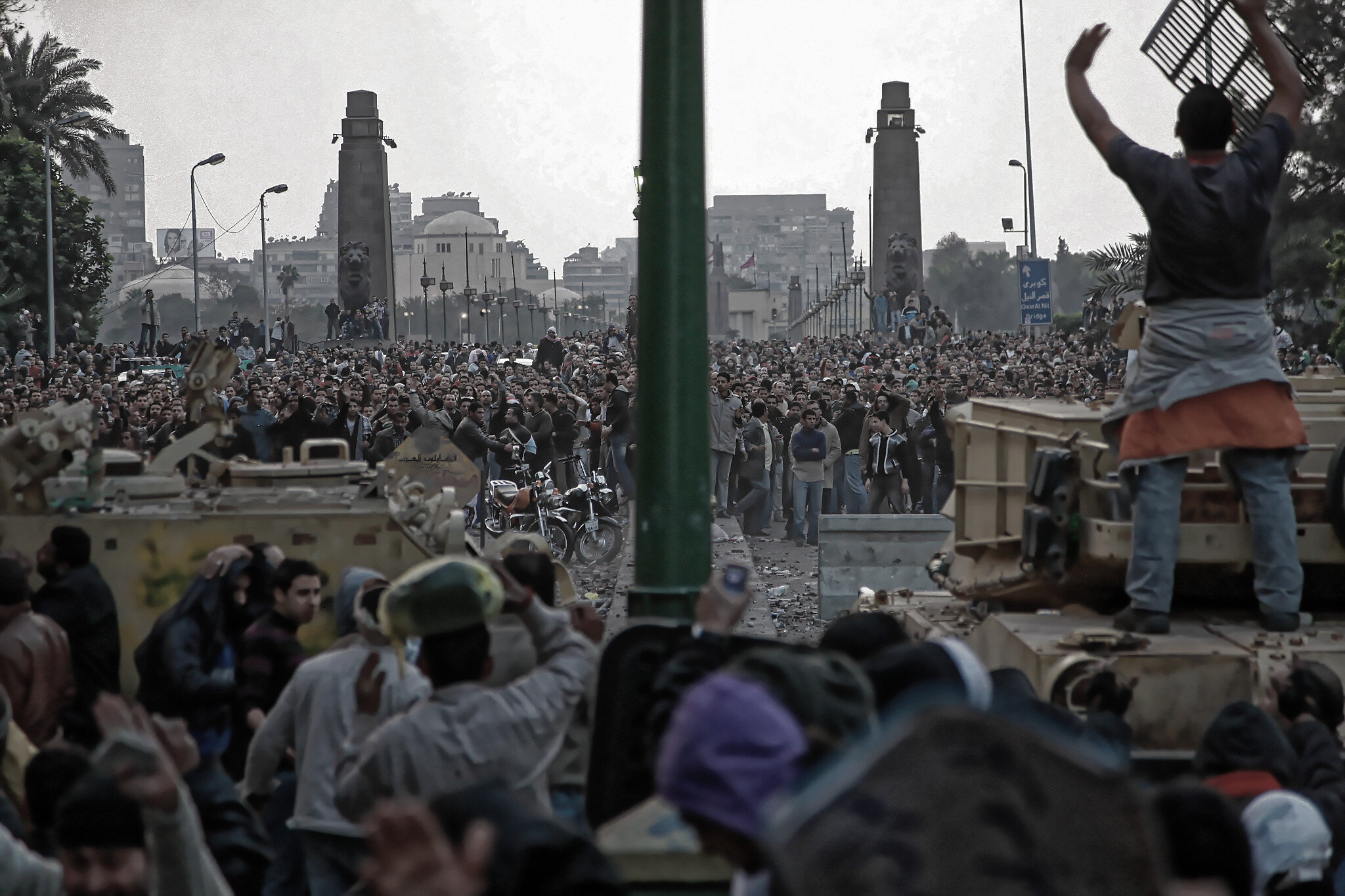 <
<
Stones, pyramid horses, Molotov cocktails and rampaging dromedaries characterized the violent night of terror that settled the Egyptian Revolution, in this remembrance with unpublished photos by one of the few photojournalists to have witnessed from inside Tahrir Square the decisive battle of the 18 days that shook the world.
Iason Athanasiadis
It didn’t occur to me, stepping out of my host’s apartment that mild February morning in Mohandeseen, a highrise 1970s Cairo district of bleak cement towers obstructing sprawling slums, that by the time I returned 48 hours later the Revolution would have largely been settled. In fact, it wasn’t yet clear that this was even a revolution, although there was a radical trajectory to the events whereby crowds defied lethal police resistance to converge and occupy the bellybutton of umm al-dunya (Mother of the World, as Cairenes call their city).
I had returned to Cairo, after a decade of estrangement, to cover for my photo agency and newspaper clients what was snowballing into a global media event, but also to fulfill a pledge of attendance I had made with myself after an awkward year of living in Egypt in 2001, which left me convinced that only a revolution could flush new vigor into an overpopulated, under-resourced country rife with corruption and dominated by an authoritarian, pro-US regime rooted in the country’s only institution, the Army.
Thousands of anti-regime demonstrators had camped out in Tahrir Square ever since running the police-state’s security services off the streets the previous Friday. Crossing the Nile, I passed the charred hulk of the regime’s official party headquarters, arsoned by demonstrators, along with several police stations.
A protest leader signals to demonstrators against the backdrop of armored army vehicles and soldiers blocking one of the entrances into Tahrir Square. The Army’s role remained ambiguous: it was often unclear whether it was there more to protect protesters or monitor proceedings.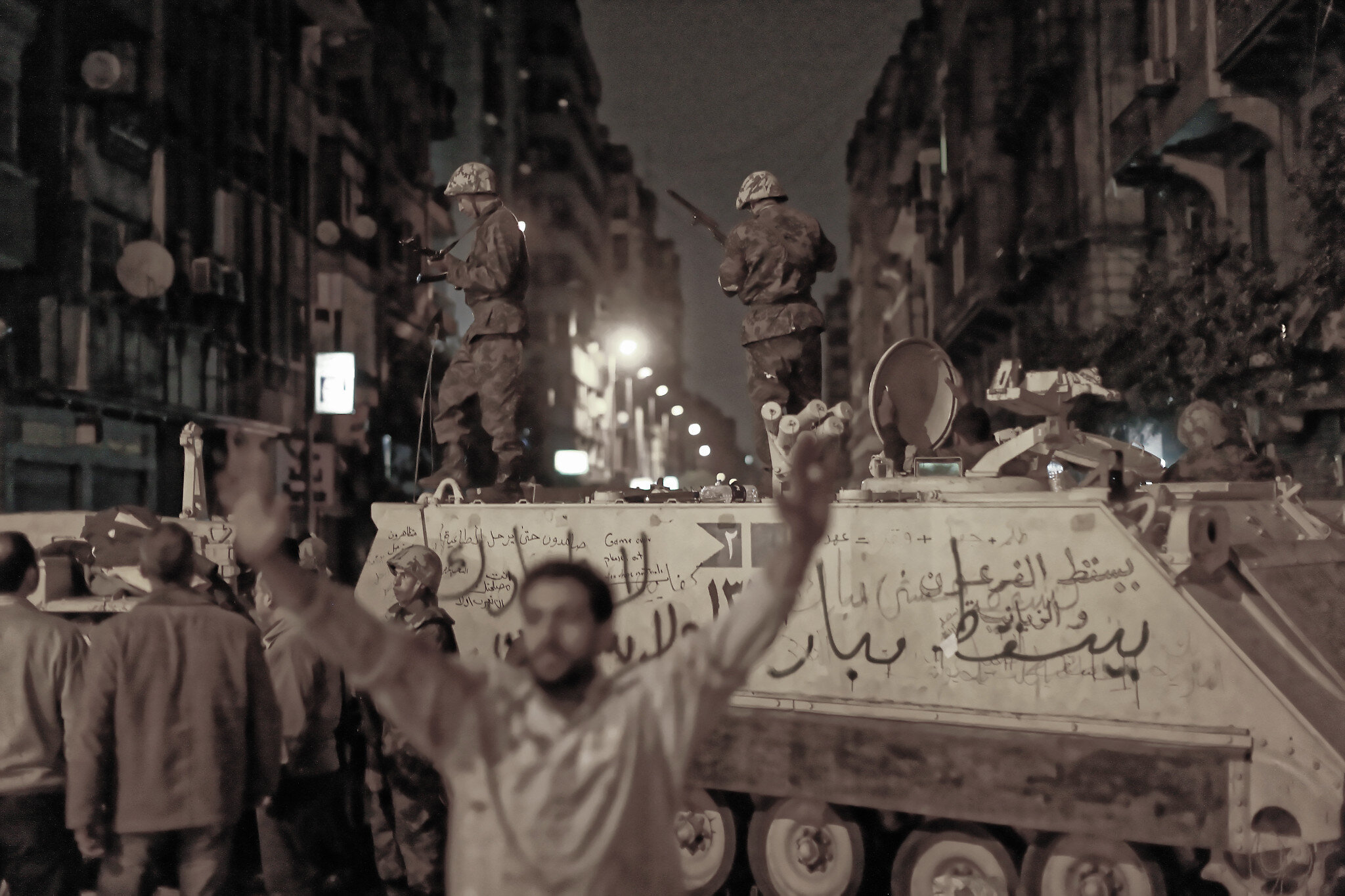 <
<
With control rapidly slipping from his fingers, President Hosni Mubarak had appeared in a midnight broadcast the previous night to address the Tahrir Square rebels for the first time, and offer concessions. But their prompt rejection of his proposal that he remain in power pending elections in nine months’ time, poised the scene for further confrontation.
Tahrir’s Incendiary Momentum
In the week since breaking out, the Egyptian revolution had transfixed humanity, rapidly escalating into the world’s main news story. Sociologists later identified the potent combination of voracious coverage by 24-hour international news networks, subsequently fed into and amplified by social media, as generating the incendiary momentum that nourished in millions of geographically-distant viewers an illusion of intimate involvement, even agency.
Growing multitudes tuned in daily to the newly-familiar Tahrir, a seething Pharaonic oculus comprising a small tent-city of indomitable rebels pitched across a gigantic square and surrounded by overwhelming forces, whose fortunes would decide the future of the deserted capital extending beyond it.
In today’s episode, the breathless global audience suspected that a merciless stick would follow Mubarak’s rejected carrot. With the Army having taken a wait-and-see approach, and the police KO’ed since the Revolution’s fourth day, regime loyalists were now being marshalled around the city to storm the square and dislodge its residents. In the stables around the pyramids, camel and horse-jockeys more used to hassling tourists, now mobilized the animals that would give the coming battle its name. Before the day was out, 11 people would be dead and hundreds more injured.
Supporters of the then-embattled Egyptian President assault from the Egyptian Museum side the thousands defending the square, in what was to prove a failed effort to dislodge them.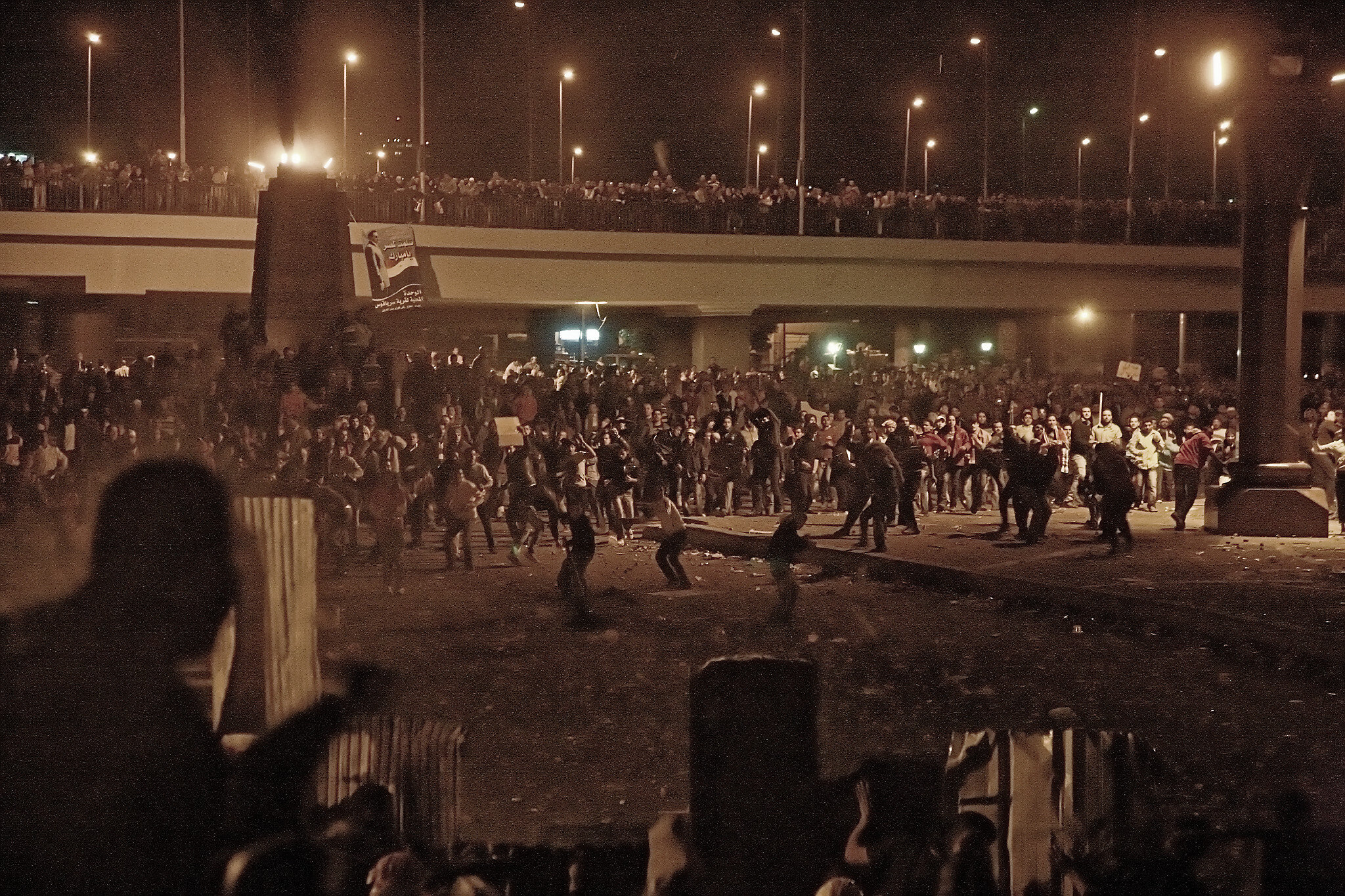 <
<
I knew little of this as I hurried through the curiously empty megalopolis of 17 million. Cairo’s monumental public buildings presided over empty avenues in an atmosphere poised somewhere between subdued Sunday afternoon and apocalyptic morning-after film. In a Ramses Boulevard suddenly bereft of thousands of exhaust-spewing automobiles, clusters of people hushedly debated each other, as hundreds of the president’s supporters made their way towards Tahrir Square, their features set in bellicose frowns.
The roar of thousands from inside the square was audible from a distance. I approached from the Qasr el-Nil bridge, where apologetic volunteers searched me and others entering to ensure we weren’t bringing in weapons. The protesters’ commitment to selmi (peaceful) opposition would soon result in their being trapped inside the square without modern means of defending themselves. Behind the volunteers were the unmistakable silhouettes of Egyptian Army tanks. The tanks and soldiers were a very real demonstration of Egypt’s most powerful and enduring institution, unblinking monitors of the faceoff, ready to intervene whenever they judged right.
The Clash
I slipped into the square as if into an expectantly seething arena. But there were only actors here, very few spectators, and hardly any of the international press that was already swarming into the country. Half an hour later, hostile Mubarak supporters closed off access to the square. The Presidents’ loyalists pressed closer, leering into the impassive faces of ranks of rebels, agitating for a reaction. Men with fresh nerves replaced those among the defenders who came close to succumbing to the urge to lash out.
Failing to provoke a fight, the Mubarak provocateurs pulled back and launched a volley of stones. Rocks rained down from the sky, ranks broke, and we fled for cover. The helmeted soldiers remained as neutral as they had promised, ducking into their tanks. I hid behind one of these, squeezing against the metal as projectiles walloped the other side.
But safety was only temporary. The defenders fell back under the Mubarakist onslaught, running towards the square. Just before reaching it, they realized that allowing the breach to happen on their side would not only bring their struggle to an end, but heap personal shame too,.
A long-bearded man in sheikh’s robes was already atop a tank, waving demonstrators back. He stood there, ignoring the rocks dropping all around him, rallying back the mostly devout defenders. It was the first of several extraordinary examples of religious fervor that I witnessed during the Arab Spring, as Muslim believers fought for better treatment than they had received under secular, army-dominated military regimes. The vision of the society they wanted to create was totally different from what the cheerleading Western liberals had in mind, and this often made for a bizarre disconnect between the western media coverage and ground rhetoric, especially when they used social media towards non-secular goals. But they were also the ones risking their lives to make that vision a reality, while the secular majority sheltered far from the barricades, either in the middle of the square, or inside their apartments.
A desperate rock war persisted, illuminated by the glare of exploding Molotovs. The push into the square by camel and horse-mounted loyalists had already been pushed back, and barricades erected. As dusk fell, the atmosphere escalated from hysteric to apocalyptic. The setting sunrays illuminated crimson clouds from below, drawing the eye down in a long cinematic tilt, past palls of smoke billowing upwards, elegantly arcing Molotov cocktails, and human masses lurching back and forth.
Prelude to Hell
The sunset call to prayer signaled a lull in the fighting. Young men shifted stones and bottles of water around the six heavily-barricaded entrances into the square. Volunteers shattered pavements into rocks, while women sentries tapped stones against railings to warn of fresh assaults and attract reinforcements. Others stood in lines, bowed in prayer, shouting between themselves “Ginna, ya naas!” (Heaven, oh people!) This transcendent moment of pure anticipation, bathed in the otherworldly light of a winter sunset, was like nothing I’ve witnessed before or since. What a fitting last sunset to behold, in case the night developed in a mortal direction.
At a makeshift clinic in a mosque just off the square, hundreds of injured were being hauled in every hour. By 7pm, doctors had registered five dead and over 1,500 injured. In a dirty alley reeking of urine and feces, bandaged patients lay in subdued bundles on pavements, nursing each other, or passing in and out of consciousness. There was no question of ambulances entering here.
Next to the Cairo Archaeological Museum, protesters hiding in a smoking wasteland of burned-out military vehicles, exchanged stones with a crowd of pro-Mubarak supporters stretching in a 200m-wide front before them. Frontline defenders fashioned protective headwear out of anything they could lay their hands on, from cardboard to kitchenware. The gathering darkness only further disguised the falling stones, which remained invisible until deafeningly striking against the makeshift metal barricades or bouncing and skidding along the ground.
After nightfall, activists, artists and intellectuals follow the ebb and tide of battle from the balcony of a penthouse overlooking Tahrir.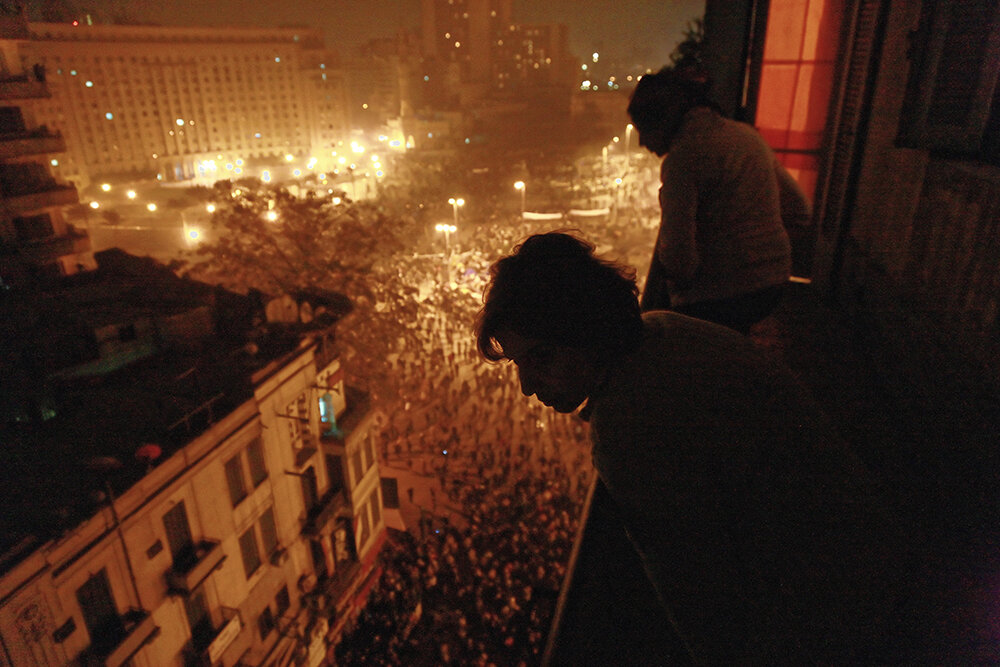 <
<
Dozens of protesters scrambled up a half-ablaze belle epoque building on the opposite side of the square, hauling cloth bags packed with stones up the staircases, to unload onto their opponents from smoke-wreathed balconies. In their precipitous overhang, above two seething crowds clashing among flaming vehicles and seas of rubble, they commanded a God’s point-of-view of the battle.
After hours in the square, and with one valuable lens already smashed, I was exhausted and in need of refuge. I retreated to the relative safety of the roundabout, where I watched snatch-squads of protesters who had ventured into the streets beyond the barricades, arriving back with their loyalist quarries. In travel agencies dotting Tahrir, they body-searched and interrogated them, discovering State Security IDs among some. Then, they stacked them in a battered, bloodied mass of humanity in the blocked-off metro station entrances.
A friend called from Athens to advise that I seek shelter with a friend of a friend who happened to live in a penthouse above the square. It was a rare residential building directly on the square, the same one whose bawwab, sheltering behind an enormous chain, had refused me entrance only a few hours earlier. But this time the owner’s name was my password, and I was soon on the threshold of a labyrinthine interwar apartment crammed with artists and secular activists, monitoring the battle for the square from wrap-around balconies and through live al-Jazeera coverage. Later, this apartment, on whose balcony an Iranian friend had spent long afternoons smoking weed a decade before with its largely apolitical actor owner, was to turn into the control room of the Revolution. Or so the New York Times thought.
The morning after: survivors of the battle resume shouting anti-Mubarak slogans as a new dawn finds them still in possession of the square.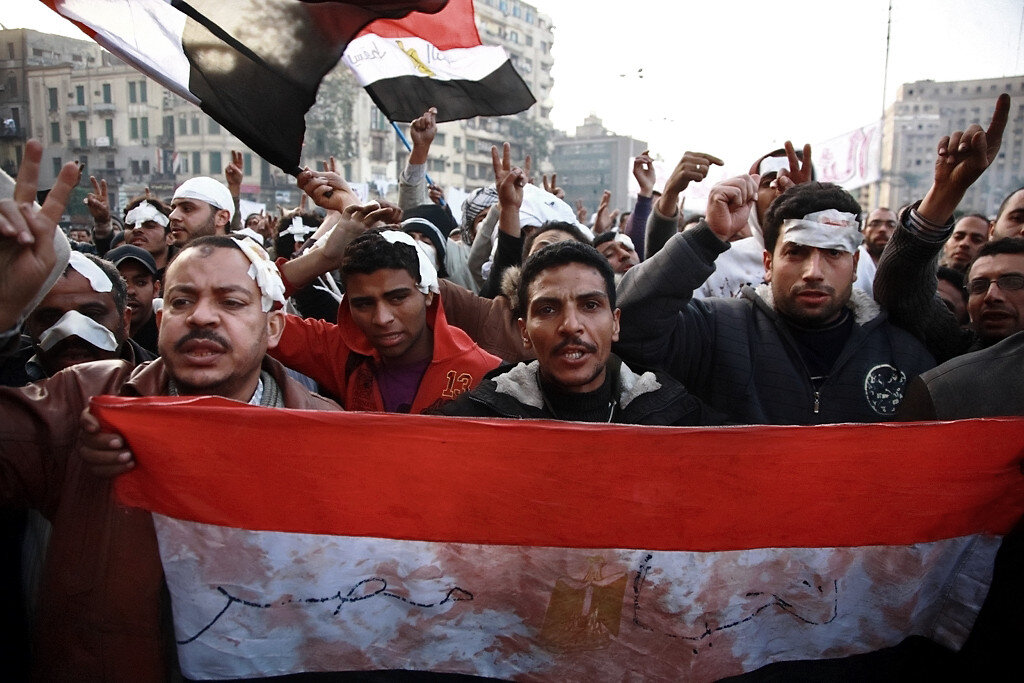 <
<
Shots rang out through the square in the middle of the night. Shortly after, some ambulances were finally allowed to enter. Later, we heard that the square’s defenders had dominated, pushing out of their area to control territory within eyeline of the Ramses Hilton. As reports of dozens of journalists being assaulted by the crowds or detained by the Army began to trickle through, I suddenly realized that I should get going.
Irhal or the End of Mubarak
At dawn, I made my way through the remnants of the battlefield. Past a line of charred, upturned cars, into an abandoned house stranded in the middle of a construction site, I sized up the risk of trying to sneak to the other side, at the risk of jeopardizing my precious photographs. In the end, I crossed over the bridge and disappeared back into a Cairo still stirring awake to the overnight news.
A few days later, under the pressure of events, Mubarak stepped down. The square went nuts; it appeared to be a new dawn for Egypt. But it would mark only a new chapter in the continuation of its troubles. This culminated, two years later, in the Army lethally clearing another square, Rabia al-Adawia, of many of the same devout, politicized people I had photographed in Tahrir. This time, the West did not condemn. Turkish President Recep Teyyip Erdogan offered the most vocal public outrage felt by many Muslims. Al-Jazeera was still frantically covering events, but somehow the western audience was no longer there. Perhaps events had become too nuanced. Ratings flagged.
I left Egypt having learned two important lessons. Sometimes you should be careful of what you wish for: destabilizing an unpleasant status quo opens the door to foreign interventions that often create even more unpleasant realities than the ones they replace. Secondly, religious radicals are good fighters. Perhaps it explains why, once a revolution turns violent, intellectuals get pushed aside.
An exhausted young activist catches a nap at dawn, following the conclusion of the battle. Still standing: a niqab-wearing protester flashes a victory sign at the Museum entrance to Tahrir Square, where the toughest battles were fought.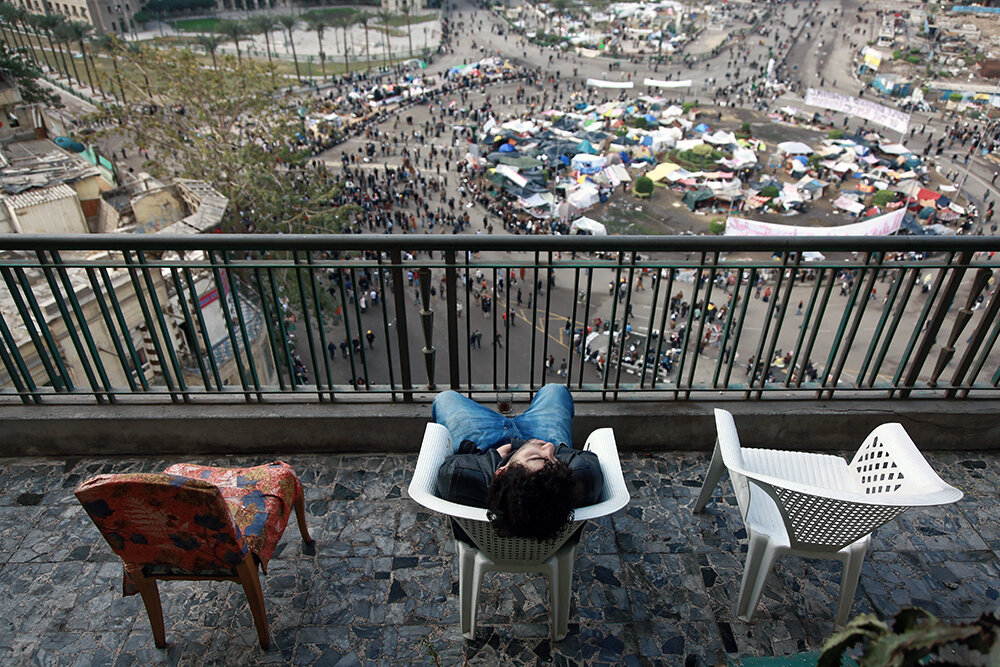 <
<
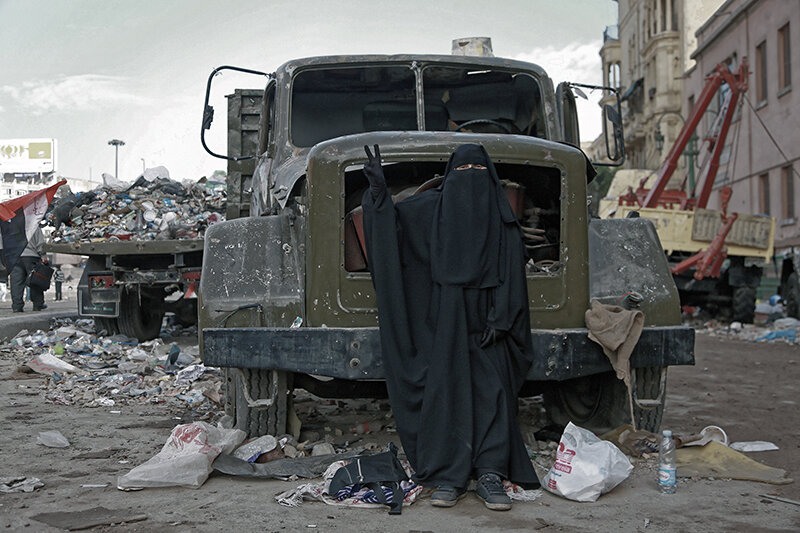 <
<




